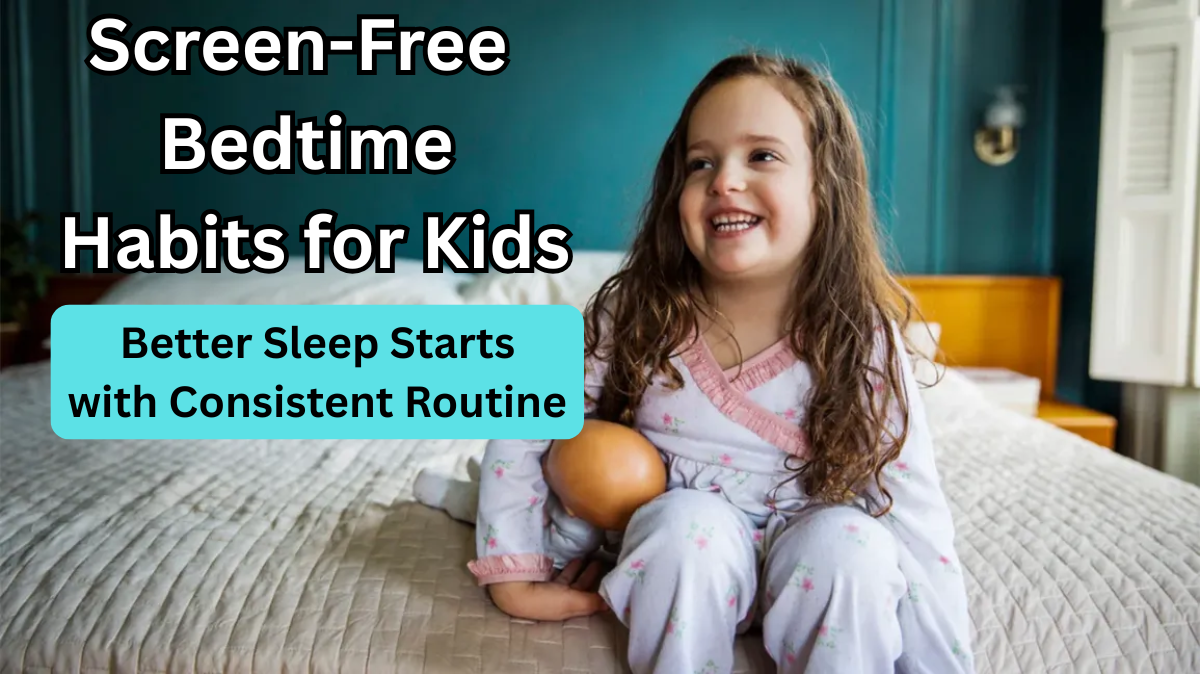A peaceful bedtime isn’t just a dream—it can be a nightly reality. In today’s digital age, it’s become increasingly difficult for children to disconnect from screens, especially at night. With tablets, smartphones, TVs, and gaming consoles becoming part of everyday life, many kids are overstimulated right before bed.
Sleep is not just about rest—it’s essential for healthy development, learning, and emotional balance. The key to better sleep? A predictable, screen-free bedtime routine that signals the body and brain that it’s time to slow down and rest.

Why a Screen-Free Routine Is Important for Kids
Children are naturally curious and easily stimulated. Screens tend to heighten that stimulation, making it much harder for them to calm down when it’s time to sleep. From colorful cartoons to high-energy games, digital content can prevent the brain from releasing melatonin—the hormone responsible for sleep.
How Screens Disrupt Children’s Sleep
| Factor | Impact on Sleep |
|---|---|
| Blue Light Exposure | Reduces melatonin production and delays sleep onset |
| Content Excitement | Keeps the mind active and alert |
| Irregular Bedtimes | Disturbs the body’s internal sleep-wake rhythm |
| Nighttime Notifications | Interrupts sleep cycles with sudden alerts and vibrations |
This is why introducing Screen-Free Sleep Habits early in a child’s life is essential. It helps protect their sleep cycle and supports their overall well-being.
The Benefits of Tech-Free Bedtime Routine Tips
Establishing Tech-Free Bedtime Routine Tips not only improves sleep but also deepens family bonding and promotes healthier behavior during the day. Some of the long-term benefits include:
-
Improved focus and academic performance
-
Reduced irritability and mood swings
-
Stronger parent-child relationships
-
Less resistance at bedtime
-
A sense of calm and security before sleep
Practical Tech-Free Bedtime Routine Tips for Every Parent
Set a Consistent Sleep and Wake Time
Consistency is key. A stable bedtime and wake-up time—even on weekends—helps regulate the child’s internal body clock. This consistency makes falling asleep easier and leads to better quality rest.
Turn Off Screens at Least One Hour Before Bed
This is one of the most crucial Screen-Free Sleep Habits to follow. Avoid all digital devices including:
-
Television
-
Tablets
-
Smartphones
-
Gaming consoles
Instead, focus on relaxing, offline activities that signal winding down.
Create a Relaxing Wind-Down Routine
Transition time is important. Children need a mental and physical shift to get into sleep mode. Try these relaxing alternatives:
-
Read a book together
-
Color in a quiet corner
-
Do gentle yoga stretches
-
Take a warm bath followed by brushing teeth
-
Listen to calming music or bedtime stories (non-screen based)
Keep Screens Out of Bedrooms
Make bedrooms a screen-free zone. This helps create a positive association between the bedroom and sleep, not stimulation.
-
Use a central charging station in the living room
-
Remove TVs, tablets, and gaming devices from the bedroom
-
Consider using an analog clock instead of a digital one that emits light
Use Environmental Cues to Signal Bedtime
Children respond well to sensory cues that signal it’s time for sleep. These include:
-
Dimming the lights after dinner
-
Playing a consistent bedtime lullaby or white noise
-
Using a night light with a soft, warm hue
-
Aromatherapy with calming scents like lavender or chamomile
These cues, when repeated daily, become powerful triggers for sleep.
A Sample Tech-Free Bedtime Routine Schedule
| Time | Activity |
|---|---|
| 7:30 PM | Bath time and brushing teeth |
| 7:45 PM | Choose a storybook or engage in calm play (puzzles, coloring) |
| 8:00 PM | Parent-child storytime or quiet conversation |
| 8:15 PM | Dim the lights, snuggle under blankets |
| 8:30 PM | Lights out, room quiet and screen-free |
Sticking to a consistent routine like this not only strengthens Tech-Free Bedtime Routine Tips, but also gives your child a sense of structure and emotional comfort.
Encouraging Your Child to Embrace Screen-Free Sleep Habits
Children might initially resist going screen-free before bed, especially if they’re used to digital entertainment. But gentle encouragement, creativity, and patience can go a long way.
Here’s how you can encourage cooperation:
-
Offer choices: Let them pick the book, the pajamas, or the bedtime activity.
-
Lead by example: Avoid checking your phone during their bedtime routine.
-
Praise progress: Celebrate even small wins like staying away from screens for 30 minutes before bed.
-
Make it fun: Create a bedtime box with books, toys, or calming sensory tools.
Real Parent Experiences
Many parents who’ve shifted to Tech-Free Bedtime Routine Tips report huge changes within just a few weeks. Children fall asleep faster, wake up in better moods, and enjoy stronger emotional regulation throughout the day. Plus, the absence of screens in the evening creates a peaceful bonding opportunity between parent and child.
4 FAQs About Screen-Free Bedtime Routines
Q1: How early should I start a screen-free bedtime routine with my child?
A: It’s never too early to begin. Even toddlers benefit from screen-free evenings. Start with simple habits like reading books before bed and keeping digital devices away from the bedroom.
Q2: What if my child insists on watching videos before bed?
A: You can offer screen alternatives that are still enjoyable—like a personalized bedtime story, relaxing music, or a cuddly routine. Stay consistent and the resistance usually fades within a week or two.
Q3: Can I use educational apps or calming videos as part of the bedtime routine?
A: While some content may seem soothing, it still involves screens. It’s better to replace them with hands-on, calming alternatives that align with Screen-Free Sleep Habits.
Q4: My child wakes up during the night and wants a screen. What should I do?
A: Avoid giving in to the screen request. Instead, offer a comfort item like a soft toy or play soft music. Reassure them gently and guide them back to sleep using the same screen-free comfort strategies.
Final Thoughts
Sleep is one of the most essential building blocks of a child’s mental, emotional, and physical growth. With rising screen time, setting firm—but nurturing—boundaries around tech is more important than ever.
By implementing these Tech-Free Bedtime Routine Tips and focusing on Screen-Free Sleep Habits, you’re not just ensuring a restful night—you’re helping your child build lifelong healthy routines that lead to better focus, emotional balance, and inner peace.
Click here to learn more
